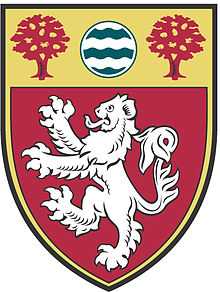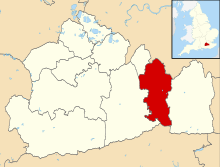The Royal Alexandra and Albert School
 School crest | |
| Established | 1758 |
|---|---|
| Type |
Voluntary aided Day and boarding school |
| President | HRH The Duchess of Gloucester |
| Headteacher | Mr Paul Spencer Ellis |
| Founder | Rev. Dr. Edward Pickard |
| Location |
Rocky Lane Reigate Surrey RH2 0TD England Coordinates: 51°15′42″N 0°10′29″W / 51.2617°N 0.1746°W |
| Local authority | Surrey |
| DfE URN | 125279 Tables |
| Ofsted | Reports |
| Students | 960 |
| Gender | Mixed |
| Ages | 7–18 |
| Houses |
Gatton Hall Rank Weston Elizabeth Edinburgh Albert Kent Gloucester Alexandra Cornwall |
| Website |
www |
The Royal Alexandra and Albert School is a co-educational boarding school located in Reigate, Surrey.[1] The current, full-time headmaster is Mr. Paul Spencer Ellis. The Royal Alexandra and Albert School Act, of 1949, united The Royal Alexandra School, which was founded in 1758, and The Royal Albert orphan School, which was founded in 1864 as a national memorial to Prince Albert. It is one of 36 state-maintained boarding schools in England and Wales and one of the few state schools in the United Kingdom to educate children from primary school years to sixth form.
History of The Royal Alexandra and Albert School
The earliest link in the school's history goes back to the Orphan Working School which was founded in 1758 by fourteen men meeting in an Inn[2] led by the Rev. Dr. Edward Pickard.[3] The school expanded under the secretaryship of Joseph Soul in Hampstead. It continued to expand and it opened a linked convalescent home in Margate.[4]
The other part of the school was known as the Royal Albert Orphan Asylum, being named in memory of Queen Victoria's husband, Prince Albert. It was situated in Camberley, just outside Bagshot's boundary, and was opened in 1864. The second school was intended for children between the age of five and eight and was founded by the Orphan Working School with Joseph Soul as the first honorary secretary.[2] In 1867 Queen Victoria planted a Wellingtonia Gigantica tree during an "Inauguration Ceremony" for the school. A "stone" at the site was engraved VIR 1867 and is mistakenly thought by some to be the foundation stone of the building. The Wellingtonia survives to this day. A later patron of the school was the Queen's son, Prince Arthur, Duke of Connaught and Strathearn. [5]
After the school left, the site was for a while used as the WRAC College. As well as learning, the boys at the school were required to work: for example on the farm, in the gardens, in a tailor's shop and in a cobbler's workshop.
The two schools, the Royal Alexandra Orphanage and the Royal Albert School joined together in Gatton Park, just after the Second World War. Over the years it evolved from an orphanage to a state boarding school. There are around 36 state boarding schools in the UK and these are schools where the education is provided by the state, but the parents pay for the boarding element. This makes their fees significantly less than independent boarding schools. List of state boarding schools in England and Wales
The school's foundation still supports some children whose home circumstances make a boarding education desirable.
History of Gatton Park
The school's grounds, Gatton Park were previously owned by Sir Jeremiah Colman of Colman's mustard and were extensively landscaped by celebrated 18th century landscape gardener Capability Brown.
Gatton Hall, the stately home built within the grounds, is now used as a boarding house for Sixth Form students.
Boarding at the Royal Alexandra and Albert School
The Royal Alexandra and Albert School is a true boarding school in that all its pupils are boarders and there is school on Saturday mornings (so that boarders can have longer holidays). Around half are full boarders who go home at weekends and for holidays. The rest are Flexi Boarders who stay for the extended day and stay overnight for between 7 and 10 nights a year.
Riding at the School
The School has its own riding stables and around 20 horses. Pupils can learn to ride for pleasure and lessons are arranged at lunchtimes or after school. Pupils can also study BTEC Horsecare as an option when studying for GCSEs or BTEC Horse Management as an option when studying for A levels. BTEC Countryside Management is also available at the School. The school is a member of the British Horse Society
Sport
The school is known for its excellent sporting facilities. Sports on offer include rugby, netball, lacrosse, hockey, swimming, football, tennis, athletics plus many others.
External links
References
- ↑ "Lessons from a state-funded boarding school". Daily Telegraph. 13 September 2010.
- ↑ 2.0 2.1 Archer, Thomas (1870). Victorian London — Publications — Social Investigation/Journalism — The Terrible Sights of London, Chapter 1 pt 3. Retrieved February 2010.
- ↑ Founders day speech
- ↑ Clark, Samuel; William Martin; Peter Parley; Ben George; Samuel Griswold Goodrich (1860). Peter Parley's annual: A Christmas and New Year's present for young people p4.
- ↑ "Sir Howard & Lady Elphinstone Miss M Muller". Bagshot Village.
| |||||||||||||||||||||||||||||||||||||||||||||||||||||||||||||||||||||
